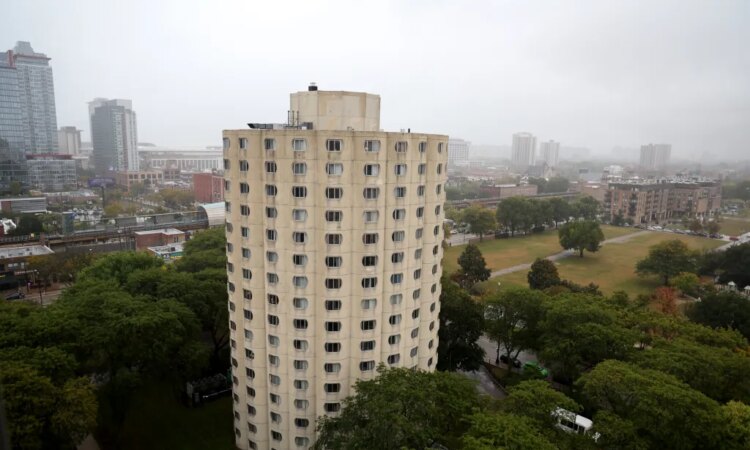
The Art Deco clock tower of the Board of Trade building in the Loop. The gilded ceiling of a Ukrainian church in West Town. The bright blue mural of Nat King Cole at the Forum in Bronzeville. Open House Chicago’s upcoming 15th annual festival offers a chance to visit these unique architectural treasures.
But this year’s event will also give residents the opportunity to visit 30 new sites, including a public housing complex on the Near South Side and an indoor mushroom farm in the West Loop.
Visitors can explore more than 200 sites across 25 neighborhoods, gaining access to condos and historic office buildings that are otherwise closed to the public. The event is also debuting three “neighborhood headquarters” across the city where guests can take a break and get information about the festival.
Adam Rubin, senior director of public engagement for the Chicago Architecture Center, the organization that produces the festival, said the event is a way for people across the city to invite other Chicagoans into their spaces and build civic engagement.
“What does it mean to have an open house and … to open up a large city like this?” Rubin said. “It builds pride in your neighborhood and a sense of agency and wanting to get involved.”

Among this year’s 30 new sites is Hilliard Towers Apartments, a public housing complex near Chinatown that has striking porthole windows, reminiscent of those on a ship. Built in 1966 by architect Bertrand Goldberg, who also built the iconic corncob-shaped Marina City complex in River North, Hilliard’s four buildings are made entirely of cement.
Two of the buildings are cylindrical and house seniors in apartments with floor plans shaped like slices of pie. During Open House Chicago, visitors will be able to go to the 16th-floor rooftop of one of these senior-housing buildings for views of Lake Michigan, McCormick Place and rail yards.
“The unobstructed views give you a feeling of openness and being at peace,” said Jackie Holsten, vice president of the company that manages properties and provides social service to tenants at Hilliard.
The gated complex has two other buildings meant for families, a community garden and an outdoor amphitheater. Holsten’s team hosts activities for tenants, such as movie nights and financial literacy seminars.
Rubin said festival organizers were excited to feature the Hilliard Towers for the first time this year to broaden people’s perceptions of public housing.


“(In Chicago) public housing is largely thought about as residential communities that didn’t succeed, many of which have been taken down over time,” Rubin said. “The Hilliard Towers Apartments are a different architectural approach to creating a sense of community. … They’re still being used today and are still a highly sought after place to live.”
The complex’s amphitheater will host performances every 30 minutes from 9 a.m. to 5 p.m., including a traditional Chinese dance, a choir concert and a tai chi demonstration.
Another new site for Open House Chicago is Four Star Mushrooms, an 11,000-square-foot indoor mushroom farm in the West Loop.
Four Star Mushrooms is among the sites that focus on where the city grows food, including the rooftop gardens at McCormick Place and the Farm on Ogden in Garfield Park, a teen-led youth farm that includes a greenhouse, commercial and teaching kitchens and a community market space.
“It might not be classically architectural, but it does speak to urban agriculture,” Rubin said.
At Four Star Mushrooms, visitors can see blue oyster mushrooms and white lion’s mane mushrooms being grown on vertical racks behind glass and learn about how mushrooms feed off organic waste material, recycling nutrients.
Joe Weber, co-founder of Four Star Mushrooms, said that as an architecture buff, he looks forward to Open House Chicago every year. He said he’s eager to be part of the event this year and spread the message about mushrooms’ environmental benefits.
“I’m excited for people to visit our state-of-the-art facility and actually see how indoor farming works,” Weber said.
Two of the new festival features are related to music. The CheckOut in Uptown is a small chamber music venue on the site of a rehabilitated 7-Eleven store that had long been vacant. Festivalgoers can hear live music between 11 a.m. and 2 p.m. each day. In Avondale, visitors can take guided tours through Electrical Audio, a manufacturing building converted to a recording studio that was used by the renowned indie musician and producer Steve Albini, who died last year.
Also new this year are three “neighborhood headquarters,” where people can pause between 10 a.m. and 5 p.m. during the festival to use the restroom, access free Wi-Fi and talk to Chicago Architecture Center volunteers to get materials or information about other festival sites.
The neighborhood headquarters are at the Ramova Theatre in Bridgeport, KOVAL Distillery in Ravenswood and Starling by Duo, a cafe and community event space in North Lawndale. Visitors can also take a break at the Chicago Architecture Center’s downtown location near Millennium Park.
Rubin said his team hopes to reach people all over the city, even those who don’t know about the event, through the neighborhood headquarters.
“It’s a way for us to attract people who might just be passing by one of these hubs and didn’t necessarily leave the house that day to participate in Open House Chicago,” Rubin said, “We want everyone in this city to feel a part of this event and to get a chance to enjoy architecture.”
Open House Chicago 2025 will be Oct. 18-19 at sites across the city; more information at www.architecture.org


